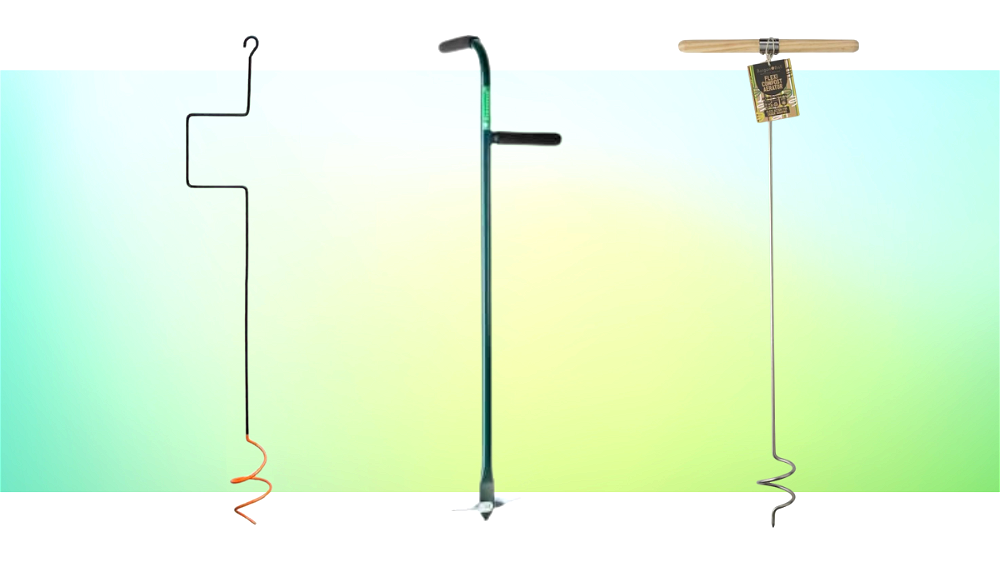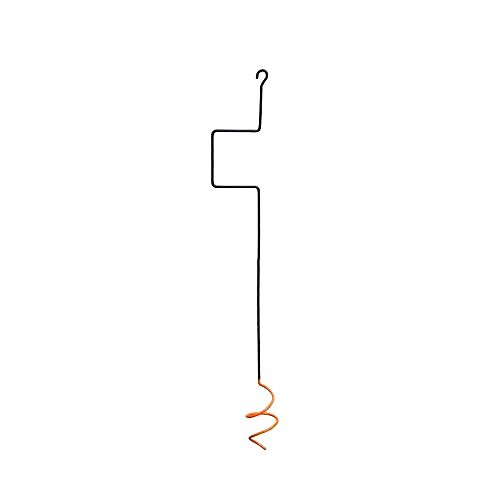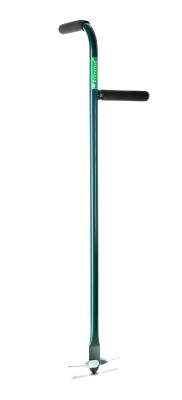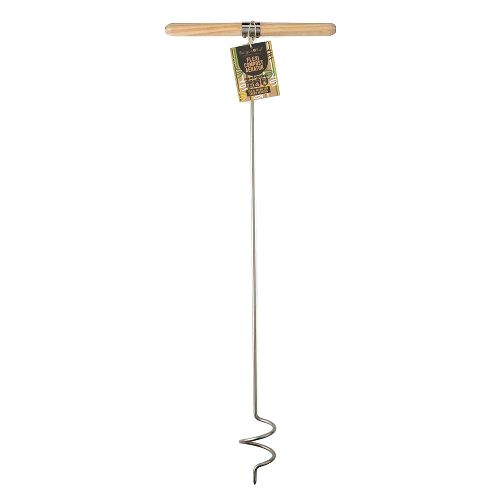Read Reviews
The Best Compost Aerators

-
Best compost aerator overall - Dolmen Compost Mixer and Aerator
-
Best for ease of use - Primrose Compost Aerator
-
Best for compacted compost - Burgon & Ball Flexi Compost Aerator
Compost Aerator Reviews
1. Dolmen Compost Mixer and Aerator[ SAVE 13% ]
Best compost aerator overall
- Simple and straightforward to use
- The galvanised steel build is very sturdy
- A great option for taller users as no bending down is necessary
- It’s easy to reach every part of the compost bin
- May struggle in very dry and compacted compost
- If your compost is very deep, using this aerator can be quite physically demanding
- Some users may prefer a wider grip for added comfort
- Type
- Corkscrew
- Length
- 1.25 m
- Rod Material
- Steel
- Weight
- 0.8 kg
- Efficiency
- 4.7
- Ease of Use
- 4.7
- Value for Money
- 4.5
Whilst it might not look like much, this Dolmen Compost Mixer and Aerator is effective in its simplicity.
Made from one rod of galvanized steel, with a corkscrew on one end, and a hanging hook on the other, there are no joins to cause weakness. The handle functions like a brace drill, and the whole thing is long enough to allow turning of all the compost in a standard bin without submerging the handle.
If you normally use a garden fork to turn compost, you’re probably familiar with how difficult that can be – it’s especially awkward trying to angle a fork into smaller compost bins. The thin design of this aerator makes it all a lot easier – it fits into any composter (even those narrow plastic ‘dalek’ ones) and can be manoeuvred to get into corners as well.
The 125 cm length means less stooping, making things easier on your back – you can pull it up whilst engaging your core, instead of having to bend over the bin and rely on your lower back to take the strain. All too often we end up putting our back out in the garden, so it’s nice to find tools that offer a bit more protection!
However, speaking of comfort, there is one thing to watch out for – there is no covering or padding on the handles, so the metal may get quite tough on the hands after a while.
This is one downside to the aerator’s basic, no-nonsense design, but wearing gloves can help.
In general, this is a simple, straight-forward tool to use. It’s best suited to compost bins that aren’t too full, so that the compost can be well turned before more is added, just to make the weight easier to manage.
Did you find this review helpful?
2. Primrose Compost Aerator
Best for ease of use
- Simple and straightforward to use - very efficient
- The handles are covered with a textured grip to prevent slipping and aid comfort
- Very easy to clean and maintain after use
- The prongs may not withstand heavily-compacted compost
- Some users find it’s not quite long enough for larger compost bins
- It is hard work to aerate large amounts of compost
- Storage can be inconvenient because the handles sit at right angles to each other
- Type
- Plunger
- Length
- 0.84 m
- Rod Material
- Steel
- Weight
- Not listed
- Efficiency
- 4.5
- Ease of Use
- 4.5
- Value for Money
- 4.4
To speed up aerating your compost, this Primrose Compost Aerator cuts out the ‘corkscrew’ twisting of other models and simply requires plunging into the compost pile.
The two steel handles are coated with a protective rubberised layer to make them more comfortable, and the way they are designed makes it possible to drive the aerator effectively into the compost.
When you decide to pull up the aerator, the zinc-coated blades on the end open out, causing the compost to be lifted too. This is a quick, easy way to aerate compost, particularly if the compost is quite loose.
As there’s no ‘twisting’ motion required, it’s better to work gradually through dense or compacted compost rather than hoping to get to the bottom of the bin straight away.
For taller users, the fact that the handle is only 84 cm long may need to be taken into consideration. This is the shortest length featured here and also means it will be difficult to reach the bottom of taller compost bins with this model.
In terms of build quality, the steel construction is sturdy and the handles seem well considered; however, this doesn’t seem to be quite as robust as other aerators (for example, those that are made from one piece of metal).
The two blades at the bottom of the aerator are hinged, and held in place with rivet, but they may struggle to bear a lot of weight; another reason to work through the layers of compost gradually if it’s compacted.
Did you find this review helpful?
3. Burgon & Ball Flexi Compost Aerator
Best for compacted compost
- The design is simple and effective
- Suitable for moderately compacted compost
- The handle is comfortable and easy to grip
- Cleaning is easy - simply shake the aerator a few times
- Smaller or weaker users may struggle to remove this aerator from the bottom of a deep bin
- The handle can be too wide for some bins and catch on the sides, meaning the bottom of the bin is hard to access
- The tip is ever so slightly off centre, meaning it’s hard to put this aerator into the compost with precision
- Type
- Corkscrew
- Length
- 1 m
- Rod Material
- Stainless Steel
- Weight
- 1.53 kg
- Efficiency
- 4.5
- Ease of Use
- 4.4
- Value for Money
- 4.4
Not all aerators are cut out for tackling very compacted compost. This is all well and good if we’re on top of our aerating schedules, but sometimes it’ll likely be easier to have a tool like the Burgon & Ball Flexi Compost Aerator around, to make tackling compacted compost simpler.
I say this because of the way it’s designed, with its corkscrew aerating spike and T-bar wooden handle. This handle makes it much easier to get a good grip, especially compared to some other aerators, and it can also be screwed into the compost using two hands. As a result, it’s one of the best compost aerators for more compact compost, as you can really use your full strength with it.
At 1 m, it’s a little shorter than the Dolmen aerator featured on this list, so it’s better suited to slightly smaller composting bins. In larger bins it’ll likely be difficult to turn the compost access the compost at the bottom, plus it’s best if you can use this aerator whilst standing over it, instead of at a side angle.
The FSC-approved wooden handle also helps with general comfort when aerating compost, wood is much easier on the hands than metal, and might make this aerator more pleasant to use during winter too.
One thing to note is the width of the wooden handle: at 37 cm wide, the handle might be too wide for some narrower compost bins. And, given the length of this aerator as well, that might mean that it can’t get right to the bottom of your compost bin if it has a narrow neck and is taller than ~90 cm.
Did you find this review helpful?
Compare Product Features
Use the dropdown to sort the table by the feature you want to see.
Dolmen Compost Mixer and Aerator
- 4.6
- Corkscrew
- 1.25 m
- Steel
- 0.8 kg
Primrose Compost Aerator
- 4.5
- Plunger
- 0.84 m
- Steel
- Not listed
Burgon & Ball Flexi Compost Aerator
- 4.4
- Corkscrew
- 1 m
- Stainless Steel
- 1.53 kg
How to Choose The Best Compost Aerator
A compost aerator is an invaluable purchase for gardeners who are keen to get the most out of their compost bins.
These tools allow oxygen to permeate the compost heap which, in turn, helps your compost break down faster and prevent it from rotting. They’re also low-maintenance items that are easy to use and simple to store.
There are a range of aerating tools on the market, so you’ll need to work out which is the best compost aerator to suit your needs.
The following information has been put together to help you make an informed choice:
The Benefits of Using a Compost Aerator
We all know that composting has a lot of advantages. However, thinking that the compost in your composter will sit and happily decompose until it’s time to spread around the garden is an easy trap to fall into.
Unfortunately, leaving your compost entirely to its own devices could well result in the material simply rotting.
Rotting and composting are two different processes, and an easy way to tell if your compost is rotting instead of composting is by the smell. Compost that is well looked after and aerated doesn’t have much of an odour – it mostly just smells like dirt. You shouldn’t notice the smell, even if the compost bin is right by your backdoor.
READ NEXT: Where to Put Your Compost Bin
Aerating compost has several benefits (not just minimising odour). It will help the organisms which are breaking down the compost to ‘breath’, allowing them to keep working efficiently. As a result, the matter will also compost quicker.
Compost which is turned more frequently (around every three days) maintains a higher heat than compost which is not turned, which is what speeds up composting.
The process of aeration helps minimise the presence of excess water in the compost which can lead to rotting. It spreads moisture around evenly within the compost bin, stopping parts of the compost from drying out whilst others get waterlogged.
For more tips on making compost at home, check out our Ultimate Guide to Composting.
Quality Aerating Tools
Making sure to buy a high-quality aerator can be the difference between having a tool that will work well for years, or ending up with something that bends (or worse, snaps!) on its first venture into your compost heap.
The best compost aerators are made from either coated/plated steel, or galvanised steel. These are generally the strongest models available and they also won’t rust easily.
There are some models on the market that are made from aluminium or plastic; these can serve a purpose if you’re looking for a quick, cheap solution, but they are unlikely to last as well as steel options.
Steel is around 2.5 x denser than aluminium making it more durable (but heavier).
Plastic aerators will be light but not very strong. They are much more likely to break, especially if they go brittle after a few years.
Compost can be surprisingly heavy so aerators need to be able to shift quite a lot of weight. You may also use an aerator to try to ‘lever’ compost from the bottom of the heap, so it is important to have a tool which is strong enough to cope with this job.
No matter what material you choose, you should store your aerator in a cool, dry place to keep it in good condition.
Corkscrew Vs. Plunger Aerator
There are two main types of aerator to choose from: corkscrew and plunger.
Corkscrew Aerators
Corkscrew aerators are twisted into the compost then pulled out. This creates air and spreads moisture evenly, the compost that was at the bottom ends up on top.
Corkscrew aerators can be used in dense compost if they work through the compost gradually. Although they’re easy to screw in to dense compost, they can be hard work to pull out if there is too much dense compost on top. Not only do you have to screw into the compost, you then have to pull the aerator out with a lot of heavy material.
Working in smaller sections is a good way to get a corkscrew aerator through denser compost.
Plunger Aerators
Plunger aerators are easier to work with in looser compost.
These have 2 folding tines or blades, which are streamlined as the aerator enters the soil and then open up when it’s pulled out. This creates large air pockets.
Initially, you only need to push a thin pole into the compost so it can be tempting to use them in very dense material. However, pulling them out is where you need to be more careful – be mindful of your back as this can be heavy work.
With plunger aerators it’s also worth being aware that the blades can break off if they are forced to carry too much weight – as an extra, hinged component on the aerator, they are a ‘weak point’; therefore, it’s often better to work through compost gradually in layers, instead of trying to shift too much in one go.
READ NEXT: Composting With Coffee Grounds – Good for Plants or Just a Fad?
How Often to Aerate Compost
How often should you be turning your compost? Everyday? Every few days? Once a year? What’s the deal?
Studies have shown that aerating compost approximately once every three days is optimum. This keeps the central temperature of the compost heap much higher compared to aerating it every 10 or 20 days.
It has been demonstrated that aerating every three days makes it possible for compost to maintain a heat of around 65 – 71°C for a period of approximately 20 days (you’ll need a compost thermometer to keep an eye on the temperature!).
Aerating every 10 days saw temperatures eventually rise (much slower) to 60°C, and aerating every 20 days saw temperature barely exceed 50°C.
Broadly speaking, hotter conditions inside the heap are better for composting.
Alternatively, if you don’t want to use an aerator to turn your compost, you could consider a tumbling compost bin instead.
Aerator Handle Design
Handle Comfort
Firstly, some aerators have padded handles and others do not. Naturally, padded handles make the work much kinder on the hands.
Wooden handles are the next best thing – they’re still more protective than metal handles and can be less cold to hold in winter.
Non-padded, metal handles are really the most basic design when it comes to aerators. Using gloves can help improve comfort.
Handle Shape
The shape and design of the aerator’s handles can make a big difference to how easy it is to use.
Corkscrew aerators tend to have either a T-bar handle or a rotary ‘brace-drill’ style handle.
A T-bar handle can make it easier to screw a corkscrew aerator into the compost, especially if the organic matter is heavily compacted. It also allows you to use both hands to pull out the aerator.
‘Brace-drill’ style handles have one hand positioned above the other. This can allow for an efficient system for pushing the end into the compost, but does mean you don’t get as much ‘purchase’ on the handles when trying to pull the aerator out. As a result, they don’t tend to be as easy to use on compacted compost.
READ NEXT: The Best Multi Purpose Compost
Compost Aerator FAQs
Regularly aerating your compost will:
- Allow oxygen into the heap. Oxygen allows the microbes that break down plant material to thrive.
- Help moisture to be distributed evenly so the heap doesn’t get too damp, or dry out.
- Increase the heat of your compost, speeding up the process of decomposition. Aerating at the right times can mean you have compost that is ready to use in as little as 8 weeks.
- Reduce any nasty odours by preventing the heap from becoming a slimy, airless mixture.
Using a compost aerator is a lot easier, and more effective, than trying to turn compost with a normal fork.
The tool needs to be inserted into the heap and then pulled out. This process is then repeated until all the compost is mixed. If your compost heap is quite compacted you may want to start working on the upper layers first, gradually moving down to the deeper layers.
Bear in mind that even with a compost aerator this is a physically testing job so don’t try to do too much at once.
If you are not physically strong enough for this task, you may want to consider purchasing a tumbling compost bin as this can easily be turned without so much physical effort.
For a hot and active compost, you should aerate approximately every 3 – 7 days. While there’s no hard and fast rule, aerating too often can slow down the process.
Check the temperature of your compost heap regularly using a compost thermometer, it should maintain a core temperature of around 71°C. When it starts to drop below this temperature, that’s your sign to aerate the compost.
When you aerate, you reactivate the microorganisms by providing them with fresh organic matter to work through.
Start typing and press enter to search




Share